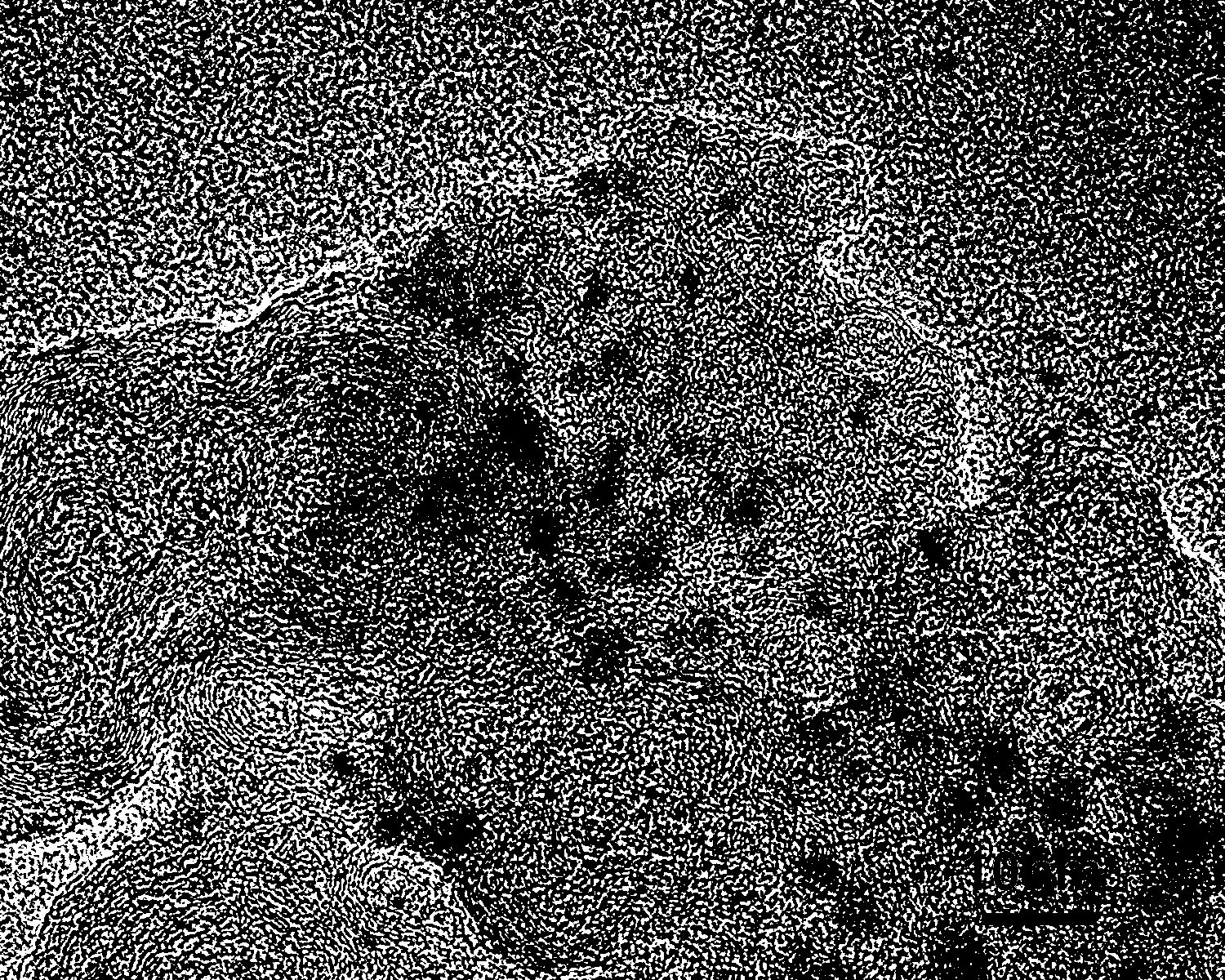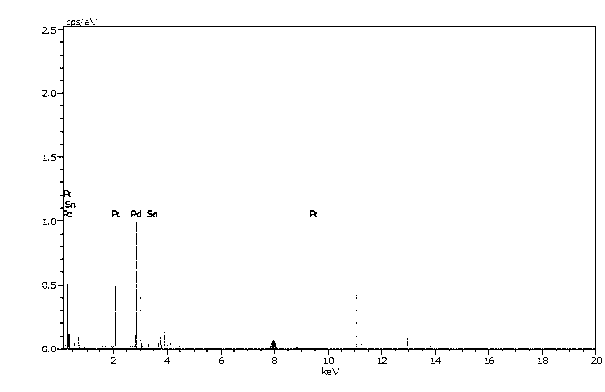Ternary carbon loaded palladium tin platinum nanoparticle catalyst and preparation method thereof
A technology of platinum nanoparticles and metal nanoparticles, which is applied in the field of electrocatalysis and material science, can solve the problems of high fuel cell prices, high platinum prices, and limited reserves, and achieve improved catalytic efficiency, anti-poisoning ability, and easy operation , promote the effect of uniform alloying
- Summary
- Abstract
- Description
- Claims
- Application Information
AI Technical Summary
Problems solved by technology
Method used
Image
Examples
example 1
[0030] A ternary carbon-supported palladium-tin-platinum nanoparticle catalyst. The catalyst is made of vulcan-72R nano-carbon powder as a carrier. The metal nanoparticle loaded is an alloy of palladium, tin and platinum. The metal nanoparticle content in the catalyst is about 40wt. %, the content of nano-carbon powder is about 60wt.%, the atomic ratio of palladium and tin in the metal nanoparticles is 1:1, and the ratio of platinum atoms to the palladium atoms or tin atoms is 0.5:1.
[0031] The above-mentioned ternary carbon-supported palladium-tin-platinum nanoparticle catalyst preparation method is as follows:
[0032] Add palladium chloride, stannous chloride, and potassium chloroplatinate with a palladium-tin-platinum molar ratio of 2:2:1 into the ethylene glycol solution, and stir ultrasonically for 2 hours.
[0033] Weigh nano-carbon powder 1.5 times the total mass of the three metal elements, add it to a citric acid solution with a concentration of 0.2 moles per liter...
example 2
[0038] A ternary carbon-supported palladium-tin-platinum nanoparticle catalyst, the catalyst is made of vulcan-72R nano-carbon powder as a carrier, and the supported metal nanoparticle is an alloy of palladium, tin and platinum, and the atomic ratio of palladium and tin in the metal nanoparticle is 1:1, the ratio of platinum atoms to the palladium atoms or tin atoms is 0.7:1, the content of metal nanoparticles in the catalyst is 20wt.%, and the content of nano-carbon powder is 80wt.%.
[0039] The above-mentioned ternary carbon-supported palladium-tin-platinum nanoparticle catalyst preparation method is as follows:
[0040] Add palladium chloride, stannous chloride, and potassium chloroplatinate with a palladium-tin-platinum molar ratio of 3:3:2 into the ethylene glycol solution, and stir ultrasonically for 1 h.
[0041] Weigh the nano-carbon powder which is 4 times the total mass of the three metal elements, add it into the citric acid solution with a concentration of 0.1 mol...
example 3
[0045]A ternary carbon-supported palladium-tin-platinum nanoparticle catalyst, the catalyst is made of vulcan-72R nano-carbon powder as a carrier, and the supported metal nanoparticle is an alloy of palladium, tin and platinum, and the atomic ratio of palladium and tin in the metal nanoparticle is 1:1, the ratio of platinum atoms to the palladium atoms or tin atoms is 0.25:1, the content of metal nanoparticles in the catalyst is 10wt.%, and the content of nano-carbon powder is 90wt.%.
[0046] The above-mentioned ternary carbon-supported palladium-tin-platinum nanoparticle catalyst preparation method is as follows:
[0047] Add palladium chloride, stannous chloride, and potassium chloroplatinate with a palladium-tin-platinum molar ratio of 4:4:1 into the ethylene glycol solution, and stir ultrasonically for 2 hours.
[0048] Weigh nano-carbon powder 9 times the total mass of the three metal elements, add it to a citric acid solution with a concentration of 0.2 moles per liter,...
PUM
| Property | Measurement | Unit |
|---|---|---|
| Particle size | aaaaa | aaaaa |
Abstract
Description
Claims
Application Information
 Login to View More
Login to View More - R&D
- Intellectual Property
- Life Sciences
- Materials
- Tech Scout
- Unparalleled Data Quality
- Higher Quality Content
- 60% Fewer Hallucinations
Browse by: Latest US Patents, China's latest patents, Technical Efficacy Thesaurus, Application Domain, Technology Topic, Popular Technical Reports.
© 2025 PatSnap. All rights reserved.Legal|Privacy policy|Modern Slavery Act Transparency Statement|Sitemap|About US| Contact US: help@patsnap.com



